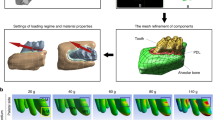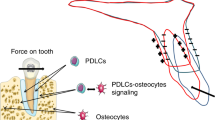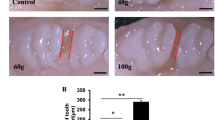Abstract
Rat's molars were submitted to orthodontic tooth movement. Bone formation areas were detected using lead-labeling technique. Osteoclasts and osteoblasts were detected by enzyme histochemistry using Tartrate resistant Acid phosphatase (TRACPase) and Alkaline phosphatase (ALPase) to determine simultaneously and mark the 2 types of cells on a same section. The sites selected for study were pressure/distal, tension/mesial and transitional areas of second molars. The results showed that: orthodontic force activated bone remodeling sequence throughout the alveolar bone; slight new bone formation was observed on the cement line on the pressure side. ALPase-positive cells were detected on the pressure side neighboring osteoclasts. On the tension side, bone formation was enhanced in the protrusions whereas both resorption and formation were observed in the depressions. In the transitional area, cellular sequence from osteoclastic bone resorption to bone formation was revealed over the cement line. These findings demonstrated that: coupling phenomena occur on the pressure side but with inhibited osteoblast activity. Bone formation on the tension side involves both promotion of bone formation by the traction force; bone remodeling sequence is established on the tension side by the interaction between osteoclastic bone resorption and bone formation that takes place in the depressions; Coupling phenomena occur in the transitional area as well. Our findings on the pressure side led to the consideration that osteoblastic cells in periodontal ligament would be involved in the regulation of osteoclastic bone resorption.
Thus, there appears to be an interaction between osteoclastic and osteoblastic cells and an activated bone remodeling sequence involving the coupling phenomena as a mechanical adaptation to orthodontic force.
Similar content being viewed by others
References
Sandstedt, C. (1904):Einige Beiträge Zur Theorie der Zahnregulierung. Nord.Tandl.Tidskr. 5:236,1904.
Flourens,J.P.: Théorie expérmentale de la formation des os. Paris 1847.
Oppenheim, A. (1911): Die Veränderungen der Gewebe insbesondere des Knochens bei Verschiebung der Zähne, öster. Ung.Vjschr.Zahnheilk. 27,302–359,1911.
Baumrind, S. (1969): A reconsideration of the propriety of the “pressure-tension” hypothesis. Am. J. Orthod, 55,12–22,1969.
Roberts, E.W. and Chase, D.C. (1981): Kinetics of cell proliferation and migration associated with orthodontically-induced osteogenesis. J. Dent. Res. 60,174–181,1981.
Utley, R.K. (1968): The activity of alveolar bone incident to orthodontic tooth movement as studied by oxytetracycline-induced fluorescence. Am. J. Orthod. 54,167–201,1968.
Ohuchi, K. (1974): Studies on the changes of the alveolar bone durig the experimental tooth movement by means of labeling methods and microradiography. Odontology 61,1072–1119,1974.
Yamasaki, K., Shibasaki, Y. and Fukuhara, T. (1982): Behavior of mast cells in periodontal ligament associated with experimental tooth movement in rats. J.Dent.Res. 61,1477–1450,1982.
Iida, J. (1982): A study on the time-course of the periodontal vascular permeability during experimental tooth movement. J.Stomatol.Soc., Jpn. 49,143–154,1982.
Davidovitch, Z., Shanfeld, J.L., Montgomery, P.C., Lally, E., Laster, L., Furst, L. and Korostoff, E (1984): Biochemical mediators of the effects of mechanical forces and electric currents on mineralized tissues. Calcif. Tissue Int. 36,S86-S97,1984.
Deguchi, T. (1969): Histochemical study in periodontal tissue during tooth movement in the rat. J.Jpn. Orthod. Soc. 28,1–11,1969.
Ochiai, H. (1987): Histological investigations on the effect of Prostaglandin E2 (PGE2) applied to experimental tooth movement. J.Jpn. Orthod. Soc. 46,500–516,1987.
Lilja, E., Lindskog, S and Hammarstrom, L. (1983): Histochemistry of enzymes associated with tissue degradation incident to orthodontic tooth movement. Am. J. Orthod. 83,62–75,1983.
Lilja, E., Lindskog, S and Hammarstrom, L. (1984): Alkaline phosphatase activity and tetracycline incorporation during initial orthodontic tooth movement in rats. Acta Odontol. Scand. 42,1–11,1984.
Kaita, K. (1988): Histological study of periodontal tissues incident to tooth movement by intermittent forces. Tsurumi Univ.Dent.J. 14,207–226,1988.
Waldo, C.M. (1953): Method for the study of response to tooth movement. J.Dent.Res. 32,690–691,1953.
Okada, M. und Mimura, T. (1938): Zur Physiologie und Pharmakologie der Hartgewebe.I.Mitteilung: Eine Vitalfärbungsmethode mit Bleisalzen und ihre Anwendung bei den Untersuchungen über die rhythmische Streifenbildung der harten Zahngewebe. Jap. J. Med. Sci. IV, Pharmacol. 11,166–170,1938.
Yoshiki, S. and Kurahashi, Y. (1972): An effective reactivation of alkaline phosphatase in hard tissue completely decalcified for light and electron microscopy. Histochemie, 29,296–304,1972.
Burstone, M.S. (1960): Histochemical observation on enzymatic processes in bone and teeth.: Ann.N.Y.Acad.Sci. 85,431–444,1960.
Burstone, M.S. (1959): Histochemical demonstration of acid phosphatase activity in osteoclasts.: J.Histochem.Cytochem. 7,39–41,1959.
Van de Wijngaert, F.P. and Burger, E.H. (1986): Demonstration of tartrate-resistant acid phosphatase in undecalcified, glycolmethacrylate-embedded mouse bone: A possible marker for (pre)osteoclast identification. J.Histochem.Cytochem. 34,1317–1323,1986.
Mayahara, H., Hirano, H., Saito, T., and Ogawa, K. (1967): The new lead citrate method for the ultracytochemical demonstration of activity of non-specific alkaline phosphatase. Histochemie 11,88–96,1967.
Sicher, H and Weinmann, J.P. (1944): Bone growth and physiologic tooth movement. Oral Surgery 30,109–132,1944.
Hori, K. (1981): A study on the vascular permeability of the periodontal membrane in relation to tooth movement. J.Stomatol.Soc.,Jpn. 48,52–66,1981.
Taguchi, M (1987): Study on prostaglandin E involve in tooth movement -Immunohisto-chemical observation-. J.Stomatol.Soc., Jpn. 54,106–128,1987.
Baron, R (1973): Remaniement de l' os alveolaire et des fibres desmodontales au cours de la migration physiologique. J.Biol.Buccale 1,151–170,1973.
Vignery, A. and Baron, R (1980): Dynamic histomorphometry of alveolar bone remodeling in the adult rat. Anat. Rec. 196,191–200,1980.
Frost, H.M.: Bone remodeling and its relationship to metabolic bone disease. Cgarles C Thomas, Springfield, Illinois, 1973.
Rasmussen, H. and Bordier, P.: The physiological and cellular basis of metabolic bone disease. Williams and Wilkins Co., Baltimore, 1974.
Hermanson, P.C. (1972): Alveolar bone remodeling incident to tooth movement. Angle Orthod. 42,107–115,1972.
Baron, R.: Importance of the intermediate phases between resorption and formation in the mesurement and understanding of the bone remodeling sequence. In: (ed. by) P.J. Meunier: Bone histomorphometry. Lab. Armour Montagu, Paris (p. 179–183), 1977.
Baylink,D.J., Farley,J.R., Howard,G., Drivadahl,R., Ed Puzas., Masuda,T., Ivey, J. and Gruber,H.: Coupling factor, advances in experimental medicine and biology. In “Regulation of phosphate and mineral metabolism” (eds. Massry,S.G., Letteri,J.M. and Ritz,E.) 151,409–421,1982.
Ozawa, H., Imamura, K., Fukuhara, T. Shibasaki, Y., Takahashi, N., Abe, E. and Suda, T.: Effect of continuously applied compressive force on bone formation and resorption in vitro. In: (ed. by) K. Kubota: Mechano-biological research on the masticatory system. Tokyo Press, Tokyo (p. 188–193), 1989.
Takahashi, N., Akatsu, T., Udagawa, N., Sasaki, T., Yamaguchi, A., Moseley, J.M., Martin, T.J. and Suda, T. (1988): Osteoblastic cells are involved in osteoclast formation. Endocrinology 123,2600–2602,1988.
Irie, K. and Ozawa, H. (1990): Relationships between tooth eruption, occlusion and alveolar bone resorption: Cytological and cytochemical studies of bone resorption on rat incisor alveolar bone facing the enamel. Arch. Histol. Cytol. 53,497–509,1990.
Hasegawa, S., Sato, S., Saito, S., Suzuki, Y. and Brunette, D.M. (1985): Mechanical stretching increases the number of cultured bone cells synthesizing DNA and alters their pattern of protein synthesis. Calcif. Tissue Int. 37,431–436,1985.
Yamada, M., Hirayama, A. and Miake, K. (1989): Morphological study responses to mechanical stretching in fibroblasts derivered from human periodontal ligaments.J.Tokyo Dent. College Soc. 89,1719–1723,1989.
Miyajima, K. (1990): Effects of periodic tension on osteoblast like cells for cell differentiation and alkaline phosphatase activity. J.Jpn.Orthd. Soc. 49,226–236,1990.
Inage, S. (1985): Tissue response of interparietal suture to tensile stimulus in vitro -Light and electron microscopic observation-. J.Stomatol Soc., Jpn. 52,143–161,1985.
Kurihara, S and Enlow, D.H. (1980): An electron microscopic study of attachments between periodontal fibers and bone during alveolar remodeling. Am. J. Orthod. 77,516–531,1980.
Oguro, I and Ozawa, H. (1988): The histochemical localization of acid phosphatase activity in BMU. J.Bone and Mineral Metabolism 6, 190–195,1988.
Oguro, I and Ozawa, H. (1989): Cytochemical studies of the cellular events in bone remodeling: Cytological evidence for a coupling mechanism. J.Bone and Mineral Metabolism 7,30–36,1989.
Author information
Authors and Affiliations
About this article
Cite this article
Mohri, T., Hanada, K. & Ozawa, H. Coupling of resorption and formation on bone remodeling sequence in orthodontic tooth movement: A histochemical study. J Bone Miner Metab 9, 57–69 (1991). https://doi.org/10.1007/BF02377987
Issue Date:
DOI: https://doi.org/10.1007/BF02377987




